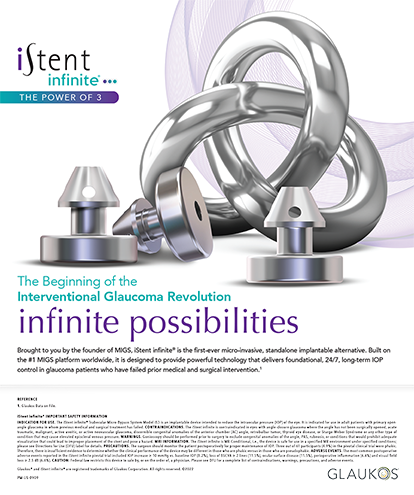Tips for Working With a Retinal Specialist, Identifying Candidates for Combined Surgery, and Modifying Your Surgical Technique
Kishan G. Patel, MD, and Arsham Sheybani, MD


Cataract surgery with IOL placement in eyes that have vitreoretinal disease presents unique challenges and considerations. This article shares pearls to help anterior segment surgeons treat patients with retinal disease more safely and effectively.
WORK WITH A RETINA SPECIALIST
If retinal pathology is suspected, we recommend consulting a retina specialist before proceeding to surgery. Careful timing of intravitreal injections and preoperative medications may be necessary to prevent postoperative worsening of preexisting retinal pathology such as macular edema, choroidal neovascularization, and uveitis.
Patients with preexisting macular pathology may be unhappy with a premium IOL because the loss of contrast sensitivity with some of these lenses may, in some cases, lead to suboptimal vision. Sometimes, high-resolution OCT imaging can identify subtle retinal findings that are difficult to detect on fundoscopic examination. Preoperative retinal imaging can help determine the most appropriate IOL for a given patient and be used to set realistic expectations.
Epiretinal membranes may worsen after intraocular surgery. An OCT scan obtained before cataract surgery can be beneficial to determine if membrane peeling may be warranted and serve as a baseline for any postoperative changes. Testing with a super near pinhole or a potential acuity meter can help identify which patients warrant a further workup for their decreased vision.
IDENTIFY CANDIDATES FOR COMBINED SURGERY
Phakic patients can experience cataract progression after pars plana vitrectomy (PPV). Combined cataract and retinal surgery may be the preferred management approach for individuals who have coexisting posterior segment pathology.
We try to avoid combining cataract and retinal surgery when biometry measurements will change significantly, such as with scleral buckle placement. In contrast, someone with an epiretinal membrane, macular hole, or silicone oil removal can do well with combined surgery.1,2 Individuals with macular pathology may have a guarded prognosis in terms of central visual acuity, but we have found that those with advanced cataracts can benefit significantly from improved paracentral and peripheral vision. For patients with diabetes who have poor vision from cataracts, waiting for improved hemoglobin A1c control may hinder their ability to take care of themselves. Delaying surgery can be detrimental overall.
INSPECT THE CAPSULE AND LENS
During the preoperative cataract examination, the integrity of the lens must be carefully examined at the slit lamp. In patients who have a history of intravitreal injections or PPV, it is important to identify areas of capsular fibrosis and linear opacities that are oblique rather than radial, which may be confused with a posterior subcapsular cataract and cortical cataract, respectively. Patients who have a history of intravitreal procedures are at increased risk of posterior capsular rupture.3,4
A careful preoperative examination can allow the surgeon to be better prepared in the OR. When capsular weakness is suspected, we counsel the patient about the risk of posterior capsular rupture and potential need for anterior vitrectomy or additional posterior segment procedures. We treat these cases similarly to posterior polar cataracts; hydrodissection is avoided in favor of hydrodelineation to remove the endonucleus. Epinuclear and cortical material can be safely removed with viscodissection, but it can be challenging to execute in post-PPV eyes given the lack of anterior hyaloid support. Additionally, patients with a history of PPV or high myopia may have zonular weakness, necessitating the use of capsular support devices during cataract surgery. These patients are also at increased risk of late IOL dislocation.5
MODIFY Your SURGICAL TECHNIQUE
OVD use. The anterior chamber may deepen significantly during cataract surgery on a post-PPV eye given the lack of a formed hyaloid to counteract an increase in anterior pressure (Figure 1A and B). When filling the anterior chamber with an OVD, avoid overinflating the eye. In our experience, the capsulorhexis typically can be controlled without allowing the IOP to become overly high. During cataract surgery, use settings close to physiologic levels and practice slow-motion phacoemulsification to promote increased surgical safety.6

Figure 1. Combined cataract and retinal surgery on a patient with a history of PPV. The trocars are placed before the start of cataract surgery (A). As a dispersive OVD is injected into the anterior chamber, it rapidly deepens, and the pupil dilates (B). Given the higher anterior chamber pressure and postvitrectomized posterior cavity, leakage occurs at the bottom left trocar, leading to an unstable pressure gradient between the anterior and posterior segments (C).
Figures 1 and 2 courtesy of Kishan G. Patel, MD
For combined procedures, we typically perform cataract surgery and IOL implantation followed by retinal surgery. In an eye with a dense cataract, the liberal use of a dispersive OVD can help maintain the view for retinal surgery.
IOL prolapse. Air or gas tamponade may prolapse the IOL out of the capsular bag if the capsulorhexis is oversized. When slight IOL prolapse occurs postoperatively, the lens may be repositioned with a 30-gauge needle at the slit lamp, but it is sometimes necessary to wait for partial absorption of the tamponade agent.
Hydration. Care must be taken not to overhydrate the corneal wounds, which can impede the view to the posterior segment. We perform light anterior stromal hydration of the roof of the main corneal wound or suture it with 10-0 nylon.
Trocars. These instruments may be placed before or after cataract surgery, but temporal trocars must be positioned carefully after cataract surgery to prevent leakage from the main corneal wound. In post-PPV eyes, we sometimes wait to place trocars until after cataract surgery to prevent leakage from the posterior segment and the creation of an unstable pressure gradient (Figure 1C).
Silicone oil. Most silicone oils are light. Their buoyancy can create a significant amount of posterior pressure. Chamber maintenance with balanced salt solution or an OVD can keep the anterior chamber formed before instruments are withdrawn from the eye. During cortical removal, silicone oil often pushes the posterior capsule flat against the anterior capsule; bimanual irrigation and aspiration can sometimes make this step easier and safer to perform.
Biometry and IOL selection. The effective lens position after staged or combined phacovitrectomy may differ from after phacoemulsification alone. There is conflicting literature on refractive outcomes—ranging from slight hyperopia to slight myopia—in this patient population.1,7,8 Some surgeons target slight myopia to offset induced hyperopia. We target -0.25 to -0.50 D of myopia and counsel patients scheduled for PPV on potential refractive error.
Optical biometry measurements may indicate an erroneously short axial length in an eye with a dense vitreous hemorrhage or retinal detachment (including tractional). In this situation, ultrasound imaging can be helpful to identify a scleral peak as an approximation for axial length. It is also advisable to refer to the contralateral eye to guide IOL selection.
Presbyopia-correcting IOLs are seldom recommended to patients with vitreoretinal pathology. Those with adequate visual potential may benefit from a toric IOL to address regular corneal pathology, but the surgeries may be staged to improve IOL stability. Patients who have a unilateral cataract and myopia should be counseled about postoperative anisometropia and management with one of the following: contralateral eye with surgery, a contact lens, monovision, or a myopic pseudophakic target.
For patients who have silicone oil tamponade, it is advisable to discuss with their retina surgeon if eventual removal of the oil is planned. Ultrasound axial length measurements can be challenging or impossible in the setting of silicone oil tamponade. Optical biometry should therefore be performed as soon as possible if rapid progression of the cataract is anticipated. When optical biometry is performed, the vitreous cavity should be changed to silicone oil so that the measurement of axial length is more accurate. Even with this setting, most biometers provide IOL power calculations as if the oil has been removed, so the power calculations may be used if the retina surgeon plans to remove the silicone oil. Until then, the eye will be highly hyperopic.
If silicone oil will remain in the eye for the long term, an IOL power adjustment should be made to account for the loss of power at the posterior surface of the lens, generally +6.00 D for biconvex IOLs (commonly implanted) and +3.00 D for plano-convex IOLs.9,10 Silicone IOLs should be avoided when silicone oil tamponade is used because oil droplets may adhere to the posterior surface of the IOL and can be challenging to remove. It can also be detrimental to place a silicone IOL and perform an Nd:YAG capsulotomy if future PPV is planned because condensation can form on the IOL intraoperatively during fluid-air exchange, impeding the posterior surgical view (Figure 2).

Figure 2. Before fluid-air exchange, there is a clear view through the IOL (A). After fluid-air exchange, there is condensation on the IOL’s posterior surface, making further posterior surgery challenging (B).
CONCLUSION
Cataract surgery can be performed safely in eyes with retinal disease if ophthalmologists are prepared for its unique challenges. Patients should be counseled preoperatively about the higher risks due to their ocular pathology. Our article in CRST’s sister publication Retina Today provides pearls on secondary IOL placement when adequate capsular support for IOL placement in the bag or sulcus is lacking (click here to read the article).
1. Daud F, Daud K, Popovic MM, et al. Combined versus sequential pars plana vitrectomy and phacoemulsification for macular hole and epiretinal membrane: a systematic review and meta-analysis. Ophthalmol Retina. Published online April 6, 2023. doi:10.1016/j.oret.2023.03.017
2. Krepler K, Mozaffarieh M, Biowski R, Nepp J, Wedrich A. Cataract surgery and silicone oil removal: visual outcome and complications in a combined vs. two step surgical approach. Retina. 2003;23(5):647-653.
3. Lee AY, Day AC, Egan C, et al; United Kingdom Age-related Macular Degeneration and Diabetic Retinopathy Electronic Medical Records Users Group. Previous intravitreal therapy is associated with increased risk of posterior capsule rupture during cataract surgery. Ophthalmology. 2016;123(6):1252-1256.
4. Mudie LI, Patnaik JL, Lynch AM, Wise RE. Prior pars plana vitrectomy and its association with adverse intraoperative events during cataract surgery. Acta Ophthalmol. 2022;100(2):e423-e429.
5. Hayashi K, Hirata A, Hayashi H. Possible predisposing factors for in-the-bag and out-of-the-bag intraocular lens dislocation and outcomes of intraocular lens exchange surgery. Ophthalmology. 2007;114(5):969-975.
6. Osher RH. Slow motion phacoemulsification approach. J Cataract Refract Surg. 1993;19(5):667.
7. Patel D, Rahman R, Kumarasamy M. Accuracy of intraocular lens power estimation in eyes having phacovitrectomy for macular holes. J Cataract Refract Surg. 2007;33(10):1760-1762.
8. Hamoudi H, La Cour M. Refractive changes after vitrectomy and phacovitrectomy for macular hole and epiretinal membrane. J Cataract Refract Surg. 2013;39(6):942-947.
9. East Valley Ophthalmology. Understanding silicone oil. Accessed July 17, 2023. https://doctor-hill.com/iol-power-calculations/silicone-oil
10. Atchison DA, Cooke DL. Determining specified IOL powers when silicone oil is to be used in the vitreous chamber. J Cataract Refract Surg. Published online March 28, 2023. doi:10.1097/j.jcrs.0000000000001190
Diabetes, Uveitis, and Epiretinal Membrane
Saagar A. Pandit, MD, MPH, and Omesh P. Gupta, MD, MBA
Many patients with coexisting retinal pathologies present to an anterior segment surgeon. With close attention to preoperative planning, surgical approach, and postoperative management, cataract surgeons can achieve excellent outcomes in this population.
DIABETES
The worldwide prevalence of diabetes was estimated to be 463 million in 2019 and is projected to be 700 million by 2045.1 People with the disease tend to develop cataracts, specifically posterior subcapsular cataracts, at an accelerated rate. They also may experience fluctuations in vision corresponding to acute rises in blood glucose, which can cause corneal edema, changes in the corneal epithelial basement membrane, and lenticular edema.
It is important for both anterior segment and vitreoretinal surgeons to evaluate patients with diabetes properly to ensure that cataract is the primary cause of vision loss. If their vision does not correspond to the grading of the cataract, a careful dilated fundus examination and appropriate imaging are necessary to assess them for diabetic macular edema (DME), retinal neovascularization, macular ischemia, vitreous hemorrhage, and tractional retinal detachment (TRD).
DIABETIC MACULAR EDEMA
The rate of vision-threatening diabetic retinopathy (DR) has increased in relation to the increased prevalence of diabetes. DME often coexists with cataracts. The preoperative evaluation entails OCT and, in select cases, fluorescein angiography. These imaging modalities can efficiently detect various pathologies, including DME, exudation, and subretinal fluid.
A patient who has center-involving DME—defined as thickening within 1 mm of the central subfield zone—will likely require a preoperative intravitreal injection of an anti-VEGF and/or intravitreal steroid injections. Leaking microaneurysms with significant exudation, moreover, may require focal laser treatment to control edema in addition to anti-VEGF injections.
Anterior segment surgeons should maintain a low threshold for referring patients to a vitreoretinal specialist to address macular edema preoperatively to maximize visual outcomes. Patients with a history of DME should also be assessed for preoperative anti-VEGF treatment to minimize the potential for exacerbation during cataract surgery.
PROLIFERATIVE DR
Complications from proliferative DR (PDR) include vitreous hemorrhage, TRD, and neovascular glaucoma. A careful preoperative evaluation includes an assessment of the undilated iris where fine, lacy vessels at the peripupillary margin can be easily missed. If the IOP is asymmetric and the cup-to-disc ratio is elevated in PDR eyes, referrals to glaucoma and vitreoretinal specialists are warranted to manage neovascular glaucoma. IOP control must be adequate before cataract surgery because phacoemulsification can result in significant IOP elevation and damage to the optic nerve in individuals with underlying glaucomatous optic neuropathy.2
Patients with visually significant cataracts often have such profound media opacity that a dilated examination is not possible. In this situation, B-scan ultrasonography should be performed to rule out vitreous hemorrhage, TRD, and rhegmatogenous detachment. In some instances, at the request of a vitreoretinal surgeon, phacoemulsification may be necessary to assess the posterior segment for neovascularization or perform panretinal photocoagulation (Figure 3).

Figure 3. A 46-year-old man with a history of type 1 diabetes presented to the Wills Eye Hospital Retina Service. He had recently undergone bilateral cataract surgery with the implantation of a monofocal IOL. An adequate view to the posterior pole and periphery demonstrated PDR with high-risk features. Note the importance of intravenous fluorescein angiography for demonstrating the full extent of disease. Anti-VEGF injections and panretinal photocoagulation were initiated.
Figures 3 and 4 courtesy of Saagar A. Pandit, MD, MPH
Two considerations for patients with PDR are whether they have silicone oil in the eye from a previous TRD and if there is the possibility of RD repair in the future. An acrylic monofocal IOL is typically preferred in these eyes. A multifocal lens, in general, should be avoided given the possibility of maculopathy. Silicone lenses have fallen out of favor given the possibility of silicone oil—whether currently present or possibly placed in the future—adhesion to the lens. It is important for anterior segment surgeons to clarify whether silicone oil will remain in the eye indefinitely or be removed in the future. In the former scenario, a correction for the presence of oil should be applied to modern biometry machines.
Postoperatively, patients must be monitored for complications such as cystoid macular edema (CME), delayed corneal wound healing, stromal edema, persistent epithelial defects, and persistent postoperative inflammation. They may develop a combination of CME and DME, which may be treated first with topical steroid and NSAIDs. If this fails to resolve the edema completely, adjunctive intravitreal anti-VEGF therapy may be initiated.
UVEITIS
The preoperative evaluation is critical to successful outcomes in individuals who have uveitic cataracts. The cases are complex for two reasons. First, the underlying cause of the uveitis must be identified. Second, posterior synechiae, zonular instability, fibrotic capsules, and a robust postoperative inflammatory response tend to make surgery more challenging.
Patients’ visual prognosis depends on the category of uveitis and whether there are posterior structural complications.3 The prognosis is better for anterior versus intermediate, posterior, and panuveitis.4 A thorough systemic workup should be performed when the etiology of uveitis is unclear. If necessary, comanagement with a rheumatologist should be initiated.
The disease should be quiescent for at least 3 months before cataract surgery is performed. At Wills Eye Hospital, where we practice, James P. Dunn, MD, the director of the uveitis service, recommends starting a combination of aggressive topical and oral steroids 1 week before surgery, administering intravenous and periocular steroids intraoperatively, and prescribing aggressive postoperative topical and oral steroids depending on the degree of inflammation.5
ERM AND VMT SYNDROME
Patients are often referred to retina surgeons for an evaluation of visually significant epiretinal membrane (ERM) and vitreomacular traction (VMT). In patients with idiopathic ERMs, the proposed pathophysiology is that, as the vitreous liquefies and detaches from its posterior attachments—a posterior vitreous detachment—the residual cortical vitreous serves as a scaffold for the migration of microglial or retinal pigment epithelial cells onto the retinal surface. These individuals may report metamorphopsia, blurry vision, or nondescript visual phenomena. When cataracts are also present, it may be challenging to attribute symptoms to the cataract, ERM, or both (Figure 4). In this situation, one option is to perform staged cataract surgery, assess the patient’s postoperative visual acuity and symptoms, and decide whether to perform a PPV with membrane peel at future visits.

Figure 4. A 71-year-old woman presented to the Wills Eye Hospital Retina Service. The patient’s BCVA was 20/50 OD. A 2+ nuclear sclerotic cataract and ERM were evident in the eye. She described glare and halos at night but was not experiencing metamorphopsia. Cataract surgery was performed. A prolonged course of topical steroidal and NSAIDs was prescribed given her mild combined tractional and pseudophakic CME. The patient’s UCVA was 20/30 OD, and she experienced an improvement in symptoms.
Individuals with primary ERMs have a higher rate of postoperative CME, likely owing to the tractional forces induced by the ERM. It should be managed medically with topical, intravitreal, or periocular steroid therapy.6
The decision to perform combined cataract and vitrectomy for ERM largely depends on the patient’s visual acuity and visual symptoms, stage of the cataract, and OCT. A combined procedure is often performed when the ERM begins to cause disorganization of retinal laminations, ellipsoid zone attenuation, or significant traction. Given the risk of future maculopathy, multifocal IOLs should generally be avoided in these patients; monofocal and toric monofocal IOLs are preferred.
The preoperative evaluation of patients with VMT syndrome resembles that for individuals with the other pathologies described earlier. Together, the anterior segment surgeon and retina specialist counsel the patient on the possibility that a posterior vitreous detachment and macular hole will be induced during cataract surgery. In a small retrospective case series of 15 phakic eyes with preexisting VMT and visually significant cataracts, all six eyes with stage 2 or 3 preexisting macular holes had stage 4 holes postoperatively.7 Patients with a preoperative macular hole identified on OCT should therefore be counseled about their likely need for a vitrectomy, either as a combined or a standalone procedure in the future. In any case where air or gas tamponade may be used, it is advisable for the capsulorhexis to be smaller than the size of the optic to minimize the risk of anterior IOL prolapse.
CONCLUSION
The retinal pathologies an anterior segment specialist encounters most often include DR, uveitis, ERM, and VMT. A detailed preoperative evaluation in coordination with a retina specialist can maximize visual outcomes after cataract surgery for these patients.
1. Saeedi P, Petersohn I, Salpea P, et al; IDF Diabetes Atlas Committee. Global and regional diabetes prevalence estimates for 2019 and projections for 2030 and 2045: results from the International Diabetes Federation Diabetes Atlas, 9th edition. Diabetes Res Clin Pract. 2019;157:107843.
2. Coban-Karatas M, Sizmaz S, Altan-Yaycioglu R, Canan H, Akova YA. Risk factors for intraocular pressure rise following phacoemulsification. Indian J Ophthalmol. 2013;61(3):115-118.
3. Mehta S, Linton MM, Kempen JH. Outcomes of cataract surgery in patients with uveitis: a systematic review and meta-analysis. Am J Ophthalmol. 2014;158(4):676-692.e7.
4. Agrawal R, Murthy S, Ganesh SK, Phaik CS, Sangwan V, Biswas J. Cataract surgery in uveitis. Int J Inflamm. 2012;2012:548453.
5. Roach L. Special considerations in cataract surgery: uveitis. EyeNet Magazine. September 2014. Accessed July 13, 2023. https://www.aao.org/eyenet/article/special-considerations-in-cataract-surgery-uveitis
6. Hardin JS, Gauldin DW, Soliman MK, Chu CJ, Yang YC, Sallam AB. Cataract surgery outcomes in eyes with primary epiretinal membrane. JAMA Ophthalmol. 2018;136(2):148-154.
7. Mantopoulos D, Prenner JL, Patel VK, et al. The effect of elective cataract extraction by phacoemulsification in eyes with vitreomacular traction syndrome. Retina. 2021;41(1):75-81.




